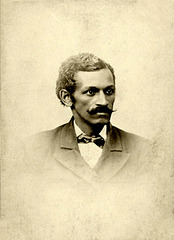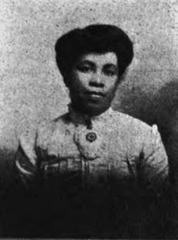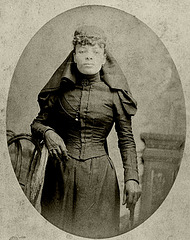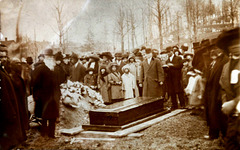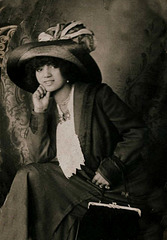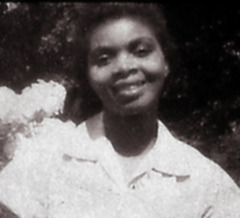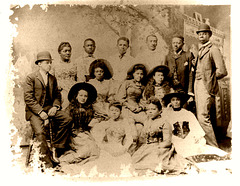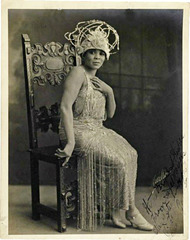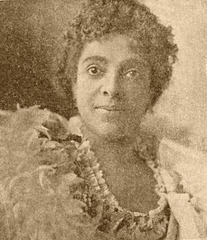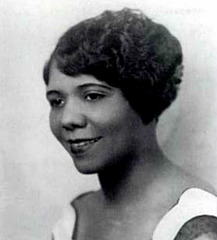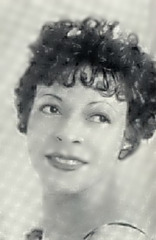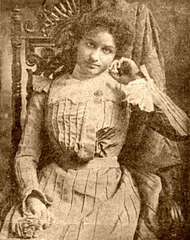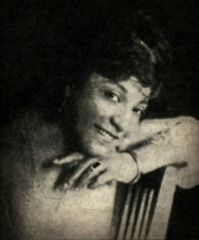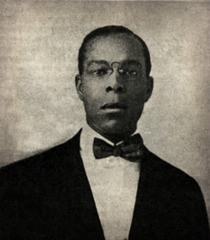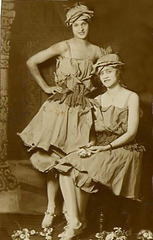Kicha's photos
Editor of the Freeman
| |
|
An 1870 portrait of George Parker the Editor of the newspaper The Freeman later called the New York Age , photographed at Hossack Palais Royal Gallery in NYC.
Jacksonville Old Folks Home
| |
|
Eartha M.M. White (in white) along with residents of the Jacksonville Old Folks Home.
Eartha Mary Magdalene White was born in Jacksonville, Florida on November 8, 1876. She was adopted by Lafayette and Clara English White. Mr. White died in 1881 when Eartha was five years old. Clara White, who was born a slave on Harrison Plantation in Nassau County, Florida, worked at various times as a maid and as a stewardess at hotels in Jacksonville and on steamboats operating from Jacksonville to various ports north at the height of the tourist industry in north Florida. A charter member of Bethel Baptist Institutional Church, Clara White was a dedicated humanitarian who had an enormous influence on her daughter. In the 1880′s, Clara White began operating a soup kitchen at her residence to feed underprivileged people in the community. This activity continued in various locations and was eventually moved to 611-15 Ashley Street in the early 1930′s. The facility was named the Clara White Mission by Miss Eartha White to honor her mother who had died in 1920.
Eartha White graduated from the Stanton School in 1893 and moved to New York City to avoid a Yellow Fever outbreak in Jacksonville. There, she attended the Madam Hall Beauty School and the National Conservatory of Music. She was selected as a member of the Oriental American Opera Company, the first African American opera company in the United States. The Oriental American included Madam Plato and Sidney Woodward and was directed by J. Rosamond Johnson, a native of Jacksonville and brother of James Weldon Johnson. The Company opened on Broadway in New York and then toured extensively for a year throughout the United States and Europe. In 1896, Miss White returned to Jacksonville to attend classes at and graduate from Florida Baptist Academy. After graduating with a college degree, she began a sixteen year teaching career in Bayard, Florida and later at her alma mater, the Stanton School in Jacksonville.
During this period, Miss White also engaged in various business enterprises including the ownership of a dry goods store on the east side of Jacksonville, an employment and housekeeping bureau, a steam laundry and a taxi company. She was a charter member of the National Negro Business League, the first woman employee of the Afro-American Life Insurance Company and a real estate broker. She had extensive real estate holdings throughout these years and used them to partially finance her businesses and settlement work activities.
In 1902, Eartha White established the Colored Old Folks’ home for indigent, elderly African Americans in Duval County that eventually became the Eartha M. M. White Nursing Home in 1967. On the same campus with the Home, she operated the only orphanage for African-American children in the State of Florida at that time. She also sponsored a home for unwed mothers, established Mercy Hospital for tuberculosis patients, pioneered public recreation programs for African American children in Jacksonville and did extensive work with prisoners. She was a member of and leader in the Negro Women’s Club Movement working along side Mrs. Booker T. Washington and Mrs. Mary McLeod Bethune among others. She was a member of the Republican Party and was a well recognized political “power broker” throughout her long life.
The Clara White Mission was headquarters for the WPA’s Negro Division and ran numerous programs to help relieve the effects of the Depression. Cultural programs, including music and art activities, occurred at that time. During WWII, Miss White established a USO for Colored servicemen and women and participated in the activities of the Red Cross. After the War and into the 1970′s, the Clara White Mission continued to provide programs for the needy, adapting to the changes in the national and local political landscape, and the social changes taking place around it.
Miss White received the 1970 Lane Bryant Award for Volunteer Service, a national award presented to her by President Richard M. Nixon. The award was accompanied by a cash gift which Miss White used for the Clara White Mission’s work. She was appointed to the President’s National Center for Volunteer Action in 1971. Eartha M.M. White never married. She died on January 18, 1974, in Jacksonville, Florida, at the age of 97.
Sources: Florida African American Heritage Network; State Archives of Florida, Florida Memory
Janie Garner Burruss
| |
|
[Photo and text: The Voice of the Negro v.3-4 (1906-07)] She was the wife of Dr. George Sanford Burruss who established the Burruss Sanitarium in 1901, in Augusta, Georgia. It was a complete hospital for blacks in the South, with twenty-seven rooms, modern equipment, a staff of twelve black physicians, and a training department for nurses.
The two married in 1899. Mrs. Burress (1876-1924), proved to be a helpmate to her husband, and frequently worked in his drug store or in the Sanitarium overseeing things. She was a graduate of Paine College, in Augusta, Georgia.
April 25, 1919 at the age of 53 her husband, Dr. Burruss died as a result of septicemia, due to a wound accidentally received while performing a surgical procedure.
Dr. Burruss and his wife are buried at Cedar Grove Cemetery, Richmond County, Augusta, Georgia.
Lady in Mourning
| |
|
An unknown African American woman poses for her portrait in mourning clothes. Georgia Division of Archives and History Hallman Bros. Artists & Photographers
Burial of a Fighter
| |
|
Gravesite of Harriet Tubman, March 1913.
Photographer, Gerald Martineau
Written on her tombstone:
To the Memory of Harriet Tubman Davis
Heroine of the Underground Railroad.
Nurse and Scout in the Civil War.
Born about 1820 in Maryland.
Died March 10, 1913 at Auburn, NY
"Servant of God, Well Done"
Erected by the Empire State
Federation of Women Clubs
Semoura Clark
| |
|
Semoura Clark, was a vaudevillian, who along with her sometime stage partner 'Bonnie' Clark (who was actually a male in drag) provided segregated entertainment for blacks in the South and Midwest. Photographs and ephemera from the Bonnie and Semoura Clark contains photographs and ephemera depicting predominantly black vaudeville acts including photographs of chorus girls, minstrels, and cross dressers, handbills and programs and two ink and wash drawings of Bonnie and Semoura Clark, dated 1913. Other popular entertainments competed with the vaudeville theater circuits for the attention of the American public. Long before the addition of kooch dances and striptease, early burlesque shows were famous for their “lady minstrels” and grand choruses of girls In flesh-colored tights. The burlesque stage was also known for its comic parodies of classical and popular drama and its own version of the full-cast finale, known as the Amazon parade.
In popular plays of the period, realism was the vogue. To effect a sense of reality, real objects and animals were substituted for stage props; all manner of things appeared on stage—from horses to trees to fire engines. One company performing Harriet Beecher Stowe’s Uncle Tom’s Cabin boasted the appearance of real hunting dogs. Historic events in the expansion of the America West were reenacted on stage as western melodramas by the Buffalo Bill Combination, led by the famous frontiersman, William F. Cody. These sensational, if often historically inaccurate, popular stage shows were soon moved to outdoor arenas. Wild West shows became a staple in American entertainment, but the most famous by far was Buffalo Bill’s Wild West Show.
Ruckus! American Entertainments at the Turn of the Twentieth Century and the Bonnie and Semoura Clark Black Vaudeville Collection recall these popular divertissements in all their variety and vivacity and celebrates the performers, both the famous and the forgotten, who were at the heart of the period’s most lively amusements.
Sources: Bonnie and Semoura Clark Black Vaudeville Photographs and Ephemera. James Weldon Johnson Collection in the American Literature Collection, Beinecke Rare Book and Manuscript Library, Yale University
Leah Pitts
| |
|
Leah Pitts of Jones County, Georgia wears a shirtwaist and long skirt trimmed with ribbon; more than likely she made both items of clothing. Though blind she was known throughout her county as an excellent seamstress. [ Georgia Historical Society ]
Irene Morgan Kirkaldy
| |
|
Irene Morgan Kirkaldy (1917 - 2007), whose defiance of bus segregation laws more than a decade before Rosa Parks’ landmark case helped lay the foundation for later civil rights victories.
LA Times
By Elaine Woo
On a hot July morning in 1944, Kirkaldy, who was then known as Morgan, was riding a crowded Greyhound bus from Hayes to Baltimore when a white couple boarded and the driver demanded her seat. The mother of two, who helped build B-26 bombers at a plant in Baltimore, refused.
She had no overarching agenda to challenge the entrenched racism of the era and no intention of picking a fight. If she had, she would not have taken a seat at the rear of the bus, in accordance with Jim Crow laws.
Morgan refused because she had paid for her seat and she wasn’t feeling well, having recently suffered a miscarriage.
“I can’t see how anybody in the same circumstances could do otherwise,” she told the Washington Post years later. “I didn’t do anything wrong. I’d paid for my seat. I was sitting where I was supposed to.”
Her rebellion led to her arrest and eventually to the U.S. Supreme Court, which decided in her favor June 3, 1946, when, in Morgan vs. Virginia, it declared interstate bus segregation unconstitutional.
The Parks case involved intrastate bus travel and attracted far more public attention, in part because of the bus boycotts that followed in its wake and the eloquent advocacy of the Rev. Martin Luther King Jr.
But “if you know the name Rosa Parks, you need to know the name Irene Morgan,” said Robin Washington, an editor at the Duluth News Tribune who produced an award-winning 1995 documentary about the freedom riders called “You Don’t Have to Ride Jim Crow!”
“She did everything that Rosa Parks did, with very little knowledge that anyone would come to her aid. Irene Morgan was simply doing what she thought was right,” Washington said.
Her case inspired the first formal “freedom ride” in 1947, when an interracial group led by civil rights leader Bayard Rustin traveled by bus and train from Washington, D.C., to Louisville, Ky., to challenge Southern states to implement the Supreme Court’s decision in the case. Their actions in turn set the mold for the famous rides across the South during the spring and summer of 1961, which helped awaken the nation to racial injustice.
On that July day in 1944 when Morgan rode the bus, all she wanted was to get home to Baltimore to see her husband and her doctor. She had left her children with her mother in Hayes and hoped the doctor would tell her she was well enough to return to work at the plant where she helped assemble B-26 Marauders.
The Greyhound was jammed, leaving her no choice at first but to stand in the aisle. After a short while, Raymond Arsenault wrote in his 2005 book “Freedom Riders,” she “accepted the invitation of a young black woman who graciously offered her a lap to sit on.” About 20 miles later, a seat opened up and Morgan sat down.
The back of the bus was an ever-shifting zone that was reduced depending on the number of white passengers. On this day, Morgan found herself sitting directly in front of a pair of whites, even though she was in the third row from the back. Because she was not sitting next to a white person, she thought she was safe. But then two more whites boarded the bus and the driver turned to Morgan and the woman next to her.
He told both of them to give up their seats. Morgan refused and also tried to stop her seatmate, a young mother, from complying, saying: “Sit down. Where do you think you’re going with that baby in your arms?”
At the next town, Saluda, the driver headed for the jail. A deputy claiming to have a warrant for her arrest ordered Morgan off the bus. “You don’t even know my name,” she told him, and ripped up the warrant.
According to her granddaughter, she then said she was willing to be arrested but warned the deputy not to touch her.
Unschooled in nonviolence but a firm believer in self-defense, Morgan made the deputy regret his next move. “When he put his hands on me, I kicked him where men should not be kicked,” she told Newsday in 2000. He hobbled off the bus, and another deputy weighed in. When he tried to grab her, “I started to bite him,” she recalled, “but he looked so dirty I didn’t want to touch him.”
She was thrown in jail, charged with resisting arrest and violating Virginia’s Jim Crow transit laws. Her mother paid $500 bail, and three months later, determined to see justice served, Morgan stood before a judge in Middlesex County, Va., to plead her case. She agreed to pay the $100 fine for resisting arrest but would not concede on the issue of breaking segregation laws.
Her decision to appeal the latter conviction caught the attention of lawyers for the NAACP, led by Thurgood Marshall, who were searching for test cases to challenge the Jim Crow laws.
Marshall and his team, which included Spottswood Robinson and William Hastie, took the case to the Supreme Court using an unusual argument. They did not argue that segregation was wrong. They argued that it impeded commerce between the states.
The court ruled 6 to 1 in Morgan’s favor, declaring that “seating arrangements for the different races in interstate motor travel require a single, uniform rule to promote and protect national travel.”
Adam Clayton Powell Jr., the black New York congressman from Harlem, called the case “the most important step toward winning the peace at home since the conclusion of the war.”
Morgan was thrilled by the victory, but it was largely ignored by bus companies, which treated the decision “as if it did not exist,” James Peck, one of the organizers of the 1947 freedom ride, wrote. As the movement moved on to other battles, Morgan returned to her family.
She faded into obscurity but didn’t shrink from carrying out a personal vision of justice. A high school dropout, she worked an extra job to put her sister through college. She helped save a man from a burning house. She drafted petitions to desegregate Baltimore schools.
Late in life, she returned to school, earning a bachelor’s degree from St. John’s University at 68 and a master’s in urban studies from Queens College at 73.
The granddaughter of slaves who had worked as a laundress and a maid, Morgan received overdue recognition in 2000 when she was 83 and the town of Gloucester, where she had boarded the bus in 1944, honored her with a day called “A Homecoming for Irene Morgan.”
The next year, President Clinton called out her name, along with those of Muhammad Ali, Hank Aaron and 25 others, to receive the Presidential Citizens Medal. The citation noted that she “took the first step on a journey that would change America forever.”
Oriental Opera Company
| |
|
Mr. Graffe, a millionaire from Syracuse, New York, wanted to prove to the world that Negroes could sing opera music as well as folk songs and financed for one year a company known as the Oriental Opera Company . Madam Plato and Sidney Woodward were the star singers and Mr. J. Rosemond Johnson was the musical director. Miss Eartha M. White, a lyric soprano from the National Conservatory of Music, was accepted as a singer. They opened at the Palmer Theater on Broadway in New York City and proved to be so successful that they traveled for one year in the United States and Europe. The above photograph is from 1893.
Source: Eartha M M White Collection
Lily Yuen
| |
|
Born around 1902, Lily Yuen grew up not in Shanghai, China, but in Savannah, Georgia, and was famous during the 1920s and 30s as a dancer, singer, and comedienne. Beneath a headline proclaiming her “A Racial Puzzle,' an article in The Afro-American (June 20, 1925 edition) revealed that “Miss Lily Yuen, a tall, agile, brown girl ... is typically Negro, and yet she is the daughter of a Chinese subject and of a colored woman." It went on to say that her father was an immigrant from China named Ton Yuen [also known as Joe Yuen] who settled down in Savannah, opened a laundry business, and married an African American woman [named Josephine, also known as Josie].
Lily started dancing professionally in 1922 and a year later was performing with Jones’ Syncopated Syncopators, an African American vaudeville revue led by Joseph Jones, who was known as “the best Jewish impersonator among colored actors” (The Afro-American, October 5, 1923). She soon earned a reputation for her Charleston strut and “eccentric” dance steps which left audiences clamoring for encore after encore.
In 1926 she joined Irvin C. Miller’s “Brown Skin Models” revue, billed in newspaper advertisements as “The Greatest Array of Colored Stars Ever Assembled” and “The Ziegfeld Follies with a Palm Beach Tan”. Lily was one of the show’s leading attractions and “a fully recognized star in her line and exceptionally in the Charlestonian realm” (Pittsburgh Courier, February 13, 1926).
By the end of 1927 Lily had left “Brown Skin Models” to form her own trio called the Three Dance Maniacs. The next year a short profile of Lily appeared in the Pittsburgh Courier (December 8, 1928), summing up her successful career thus far: Fifty Thousand Dollar Legs ... This may be only a small part of the real value of the shapely dancing limbs of one Lily Yuen, good looking, fine personality and a stage favorite wherever she puts on her large flat shoes, sweater and cap that rests at a saucy angle upon her pretty tresses. Miss Yuen has been dancing about five years. Reaching efficiency of a charming type which placed her on many bills in big time white houses, where she never failed to score. Sometimes she works in a trio other times alone. But at all times she is earnest and a hard worker. She originates all her steps, many of which are now being copied and used by Broadway white girls.
Around this time Lily settled down in New York and during the next few years performed in such shows as “Ginger Snaps of 1929”, “Fidgety Feet”, “S’prise Me!”, and “Jazz-Mad”. She continued performing throughout the 1930s, including a stint with Ethel Waters in 1938. Lily was reported to have married in 1941, but that didn’t seem to stop her career. In 1946 she was headlining nightclubs in Baltimore and Washington D.C.
She was interviewed in the 1980s and told of how she once shared an apartment with several chorus girls one of whom was Josephine Baker. “People always say she was in the Cotton Club,” Lilly complained. “Josephine wasn’t in no Cotton Club. She was just a chorus girl, baby, we all was chorus girls.”
At this point I have yet to find a death notice or obituary for Ms. Yuen.
Sources: Penn Studio; softfilmblogspot, by duriandave
Hazel Meyers
| |
|
Hazel Meyers was a vaudeville artist in the 1920s who made blues records ... a total of forty-one songs between September 1923 and August of 1924, primarily for Ajax, but also for Brunswick (issued on Vocalion), Pathé, Banner, Bell, and Emerson. Her last two sides were made for Okeh in June, 1926. She frequently worked with accompanists of outstanding quality, including Fletcher Henderson, Porter Grainger, Bubber Miley, Don Redman and even, on one occasion, Fats Waller. Her career as a vaudeville stage artist is a bit sketchy. She appeared in Steppin' High, a Harlem variety show for which Fletcher Henderson's Orchestra provided the music, and is known to have made other appearances in on the black vaudeville circuit through 1930. Little else is known about her.
AllMusic, by Dave Lewis
Anna Madah Hyers
| |
|
Anna Madah Hyers was regarded as the first black woman to enter the concert world. She paved the way for many prosperous black concert singers like Marian Anderson, Paul Robeson, and Leontyne Price.
Born in Sacramento, California in 1856, Hyers spent much of her childhood studying music with her father, Sam Hyers, a musician, and with German music professor Hugo Sank. Together they transformed Hyers' immature soprano voice into an angelic powerhouse.
In 1867, Hyers made her professional debut at the Metropolitan Theater in Sacramento with her younger sister Emma Louise. Because the sisters shared the same talent, they would occasionally sing duets. Their performances were a success and ensured them a leading position among the prima donnas of the age. In 1871, the Hyers sisters performed their first major recital.
The Salt Lake Theater in Utah welcomed them along with baritone Joseph LeCount. Anna's soprano, Emma's alto tenor and LeCount's baritone sounded so riveting in harmony that they left the audience wanting more. Soon after the successful recital in Salt Lake City, the Hyers sisters were encouraged to launch a national tour. Following the tour, they formed the Hyers Sisters Concert Company, which performed concert music and staged musical comedies. Some of the most recognized productions were "Out of Bondage" (1875), "Urlina, or The African Princess" (1877), and "Colored Aristocracy" and "The Underground Railroad," which were both introduced in 1879. The production company faded after her younger sister Emma's death in 1899. Yet Anna continued singing and touring the United States with other production companies until her retirement in 1902. She died in Sacramento, California of a heart ailment in 1925.
Info: Pittsburgh Post Gazette , by Angela Dyer (March 1999), Photo: Stella Wiley's Scrapbook
Aida Ward
| |
|
Aida Ward (1903 - 1984), was a nightclub, stage, and radio singer in the 1920s and 1930s who popularized the hit song, "I Can't Give You Anything But Love, Baby" and "I've Got The World On A String."
Her professional career began on Broadway in 1924 as a featured singer in the musical "Dixie to Broadway." The production was a star vehicle for Florence Mills. It was the first all-Black show to have a mainstream Broadway production.
Known as the "prima donna" of the Cotton Club in Harlem, she was already a star in her own right when she became successor to the great entertainer Florence Mills. And was featured vocalist with the Duke Ellington and Cab Calloway orchestras. She was a headliner at the Cotton Club when she befriended Lena Horne, who was 17 at the time and a novice chorus girl.
She appeared in New York, London and Paris in the hit play Blackbirds (1926-27 run), and, after Florence Mills death, shared star billing in Blackbirds of 1928 with singer Adelaide Hall.
She also sang on national radio programs.
She retired from show business in the late 1940s and returned to Washington where she operated a nursing home. She retired for the second time in 1969.
Miss Ward, a graduate of Dunbar High School, was a member of the Seventh Church of Christ Scientist in Washington, where she was active on the music committee.
Her marriages to Walter Gist and Edward Chavers ended in divorce. A son by her first marriage, Jerome Gist, died in 1983. Survivors include one grandchild.
Her final days were spent in a nursing home in her native Washington DC., where she died at the age of 84 of respiratory problems at Howard University Hospital.
Source: Washington Post
Maude Russell
| |
|
New York Times
March 29,2001
by Joyce Wadler
Maude Rutherford, 104, Dies
High-Kicking Songster of 1920's
Maude Russell Rutherford, a singer and dancer in the glory days of black theater in the 1920's who always said she was the one who really introduced the Charleston on Broadway, died on March 8 at her home in Atlantic City. She is believed to have been 104.
Strikingly pretty, she was billed as the Slim Princess when she worked with Josephine Baker, Fats Waller and Pearl Bailey. Never a star, Ms. Rutherford was usually the soubrette or a featured performer and a great favorite at Harlem's Cotton Club.
She wrote her particular footnote to history in 1922 in the Broadway show ''Liza, '' an all-black revue with lyrics and music by Maceo Pinkard. While many dance histories credit the 1923 show ''Runnin' Wild'' with bringing the Charleston to Broadway, Ms. Rutherford led the ''Liza'' chorus girls in the dance a year earlier.
She remained proud of her dance abilities to the end of her life.
''I used to kick 32 times across the stage, and my legs would hit my nose,'' Ms. Rutherford told Jean-Claude Baker, who was reared by Josephine Baker and who is a student of black entertainment. ''I was a dancing fool.''
Ms. Rutherford was born in Texas to a black mother, Margaret Lee, and a white father, William McCann. With interracial unions prohibited, her parents never lived together.
As a teenager working as a ticket taker, Ms. Rutherford met Sam Russell, a star of the black theater with the comedy team Bilo and Ashes. He asked her to go on the road with him. She demanded marriage first. The marriage was violent and short. Ms. Rutherford, weary of being beaten, surreptitiously relieved her husband of $100, then struck out on her own.
Tall, with a sweet voice, she would play the bouncy, good-time girl, perhaps the comic relief. ''I'm Forever Blowing Bubbles'' was a youthful audition choice. Early in her career a producer tried to mold her as a blues singer, but, as Ms. Rutherford told Mr. Baker in a taped interview, it did not fit. The producer said, ''Honey, you stick to bubbles.''
Her style offstage was down to earth and no-nonsense, and she used language too vivid to be called plain-spoken; she described one colleague as ''so ugly she could take a stick and break day.''
Ms. Rutherford's theater credits included ''Dixie to Broadway'' (1924), ''Chocolate Scandals'' (1927) and ''Keep Shufflin' '' (1928). She left show business in the 1950's and in 1953 married her fifth husband, Septimus Rutherford, chief steward for the Moore-McCormack Lines. She worked as a switchboard operator in an Atlantic City hotel.
But she never lost her show-biz flair.
When her husband died in 1980, Ms. Rutherford had her name carved into the headstone she and her husband would share, as well as a birth date, Mr. Baker said.
But instead of 1897, which she had told friends was the year of her birth, the carved date was 1902.
''She said, 'By the time I die, nobody will be here to remember, so I will go forever in eternity five years younger,' '' Mr. Baker said.
Jean-Claude Baker Foundation
Belle Davis
| |
|
Belle Davis was an African American song and dance artist, entertainer, choreographer, and director. She was a recording pioneer who toured Europe extensively during the period 1901-1929. Not only did she record on disc as early as 1902, she also performed in front of a movie camera at least twice during the early years of this century. In spite of these extraordinary achievements, little has been written about her; her biography, her discography and her filmography remain sketchy.
Belle Davis, (1874 - circa 1938), was born in Chicago, Illinois on April 28, 1874, the daughter of George Davis. Of European and African ancestry, she spent most of her adult life abroad, largely in Britain, where she arrived in mid-1901 with two boys who were billed as Piccaninny Actors. Her performance style changed from ‘coon shouting’ and ‘ragtime singing’ in the 1890s to a more decorous manner, where prancing children provided the amusement. She directed their stage act, and with two, sometimes three or four, black children the act was a vigorous and popular entertainment in British and continental theatres.
Davis's troupe appeared on the reputable Empire Theatre circuit in late 1901, recorded in London in 1902 (including the song ‘The Honey-Suckle and the Bee’), continued touring London and the provinces in 1903, and ventured to the continent. Dozens of other African-Americans were entertaining the British at this time, and on June 9, 1904 Davis married one of the more successful, Henry Troy, in London. Following her marriage the act continued to tour, and was filmed, for commercial distribution. The Empire circuit continued to employ the group, as did other leading theatres. They presented their ten-minute stage act in Dublin, Cardiff, Swansea, Manchester, Birmingham, Nottingham, Leicester, Edinburgh, Liverpool, and Sheffield between May 1906 and August 1909, and appeared in Berlin, The Hague, Paris, Vienna, St Petersburg, and Brussels during the same period. Some leading performers had their apprenticeship as dancers in Davis's act; when they grew too large she recruited younger boys from America.
The act had been seen by hundreds of thousands of Britons by 1914, when war prevented continental touring and so exposed more Britons to Belle Davis and Her Cracker Jacks. She and the children performed in major cities as well as Ayr, Doncaster, Portsmouth, Ilkeston, and Weymouth during the war years. Her last known performance in Britain was in 1918. From 1925 to 1929 she directed the dancing in the revues at the Casino de Paris, and 1929 also saw Belle Davis Piccaninnies in Germany with Wunderland der Liebe, a revue set in the south seas. As early as 1915 she was describing herself as married to the African American entertainer Edward Peter (Eddie) Whaley (circa 1880–1960), and she took out an American passport in the name Belle Whaley in 1920. She and Whaley eventually did marry, on July 12, 1926, but they had divorced by 1936. In 1938 she boarded the Queen Mary in Southampton to return to a Chicago address.
Sometimes billed as a ‘creole’, Davis was a soprano whose songs were not from the minstrel show or spiritual traditions, but were graceful melodies. By contrast the children were energetic dancers who combined suppleness with comedy. Their well-dressed director's elegance was praised, and is evidenced by surviving promotional material. The mercurial entertainment business had few acts for whom top theatres provided employment for the length of time she worked in Britain. Her qualities both as a singer and as dance director, combined with her professionalism in travelling from town to town, country to country, in charge of boisterous children, were solid, and enabled her to have success at her chosen profession for three decades. Stately, well dressed, and showing faint African features, she presented American dance and song to countless Britons and kept top employers anxious to take her act for their shows.
Sources: Jeffrey Green and Rainer E. Lotz
Cleo Desmond
| |
|
Born Matilda Minnie Hatfield in 1888 in Philadelphia, Pennsylvania. She was an actress of stage and screen. Active in the entertainment field from the 1900s til the 1940s. She performed in vaudeville under her original name, first with 'Parson Johnon's Flock,' a big attraction that played Hyde and Behman's Theater in Brooklyn, New York (1901), then with Joseph J Flynn's Nashville Students (a group organized in NYC, not the original famous group founded by P.T. Wright), which toured for a season of fifteen weeks in and around NYC (1902). At what point she joined the Williams & Walker Company is not known, but she toured Europe with that famous troupe (possibly 1902-1908), taking the stage name Cleo Desmond.
In 1909 she performed with Ed Brayer's 'Georgia Campers,' a vaudeville ensemble presenting songs and dances of the South, which played at the Green Point Theater in Brooklyn, NYC. With this act, she and her dancing partner Clarence Bowens, as the team of Desmond & Bowens, performed a so called lazy coon dance. She also performed a solo "song recitations," wearing a seductive, "split to the hips" sheath skirt. Her last recorded vaudeville engagement was in a sister act, billed as Desmond & Bailey (partner unknown), a performance of songs and monologues, which played at the Columbia Theater in NYC (1909).
Beginning in 1916, as a former member of the Anita Bush All-Colored Dramatic Stock Company she became a member of the original company of Lafayette Players at the Lafayette Theater in Harlem, NYC, where she soon established herself as one of the company's featured players (circa 1916-1922), best remembered for her role as the landlady in Dr. Jekyll and Mr. Hyde.
She performed in several all-Black films of Oscar Micheaux. In 1938 she performed in the Los Angelos production of Hall Johnson's 'Run Little Chillun!'
She died in 1958, in San Diego, at the age of 70.
Sources: The Competitor vol. 1, 1920 ; Profiles of African American Stage Performers and Theatre People, 1816-1960 by Bernard L. Peterson
RomeoL Dougherty
| |
|
New York, NY, Saturday December 16, 1944,
Romeo Dougherty is Dead
Romeo Dougherty, Vet
Negro Sports And
Drama Critic Dead
Romeo L Dougherty, who was prominent in the newspaper profession for almost 40 years during which he became known as the "Dean" of sports and dramatic editors, died Saturday afternoon at his home in Jamaica, Long Island, at the age of 59.
In failing health for years, Mr. Dougherty was bedridden for the past three months, a victim of dropsy and resulting complications. His death followed a heart attack early Friday morning.
Mr. Dougherty was known to intimates as "The Sage of Union Hall Street," partly because of a penchant for poetic and philosophic comment, and partly because of his avid reading habits. His private library consisted of close to 2,500 volumes, including many rare works on the Negro. It was his boast that he had read every book in this collection from cover to cover.
A native of St. Thomas, Virgin Islands, he migrated to this country when he was eight years old. He entered the newspaper field at an early age, starting on the now defunct Brooklyn Eye. He was next employed by the New York News, a Harlem publication founded by George W. Harris, and joined the editorial staff of the Amsterdam News around 1910, remaining with that publication until 1935. Since that time he has done freelance work for a number of national publications.
Dougherty is survived by his widow Frances and a cousin, Edwin McKetney of Harlem.
An impressive tribute by the sports world was paid Sunday night at the Renaissance Casino when Bob Douglass interrupted the feature game between the Renaissance and the New York Nationals and the audience stood in silence for one minute while "Taps" was played on cornet by a member of Don Wilson's band.
Source: The Competitor, vol. 1, 1920
Montrose Sisters
| |
|
These two young ladies were dancers on the vaudeville stage. Photographed at Penn Studio. Pennsylvania Historical Society

